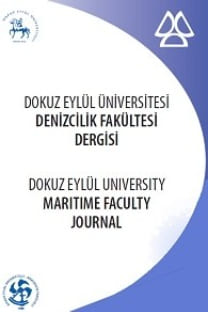TAYFA SINIFI GEMİ ADAMLARI ARASINDA TEMEL EMNİYET EĞİTİMİNİN ETKİNLİĞİ
İnsan hatası, Temel Emniyet Eğitimleri, Eğitimlerin Etkinliği, Gemiadamları
EFFECTIVENESS OF BASIC SAFETY TRAINING AMONG RATINGS
Human Error, Basic Safety Training, Effectiveness of Trainings, Seafarers,
___
- Albayrak, T., and Ziarati, R. (2012). Encouraging research in maritime education & training. Journal of Maritime transport and engineering, 1(1), 4-10.
- Asyalı, E., Tuna O. and Cerit, A. G. (2004). Denizcilikte aktif eğitim ve kalite yönetimi. 1. Aktif Eğitim Kurultayı Bildiriler Kitabı, 67-75, İzmir.
- Aşkın, F., Yılmaz, S. and Yalçın, E. (2013). Dünya Denizcilik Eğitim Faaliyetleriyle İlgili Genel Bir Kıyaslama. Journal of ETA Maritime Science, 1(2), 9-18.
- Barsan, E., Surugiu, F. and Dragomir, C. (2012). Factors of Human Resources Competitiveness in Maritime Transport. International Journal on Marine Navigation and Safety of Sea Transportation, 6 (1), 89-92.
- Berg, N., Storgård, J. and Lappalainen, J. (2013). The Impact of Ship Crews on Maritime Safety. Publications of the Centre for Maritime Studies Unıversity of Turku A, 64, 1-48.
- Bolaños, E. K., Boone, J. R. M., Lauresta, E. V. M. and Calinao, R. J. G. (2016). Effectiveness of Basic Safety Training as Perceived by Filipino Seafarers. LPU–Laguna Journal of International Tourism and Hospitality Management, 3(2), 8-21.
- Buted, D. R., Felicen, M. S. S., Macatangay, J. E. G., Andal, N. J. F., Pangpang, K. N. R., Suayan, M. C. V., and De Leon, J. D. (2014). Effectiveness of basic safety training among cruise line students. Asia Pacific Journal of Multidisciplinary Research, 2(3), 161-169
- Chauvin, C., and Lardjane, S. (2008). Decision making and strategies in an interaction situation: Collision avoidance at sea. Transportation Research Part F: Traffic Psychology and Behaviour, 11(4), 259-269.
- Cohen, J. (1988). Statistical Power Analysis for the Behavioural Sciences, 2nd Edition, Hillsdale, NJ: L. Erlbaum Associates.
- Demirel, E. and Bayer, D. (2015). Improvement of safety education and training for seafaring officers. Electronic Journal of Social Sciences, 14(55), 54-67.
- Gekara, V. (2008). Globalization, State Strategies and the Shipping Labor Market: The UK's Response to Declining Seafaring Skills. PhD Thesis, Cardiff University, United Kingdom.
- Hanzu-Pazara, R. and P. Arsenie (2010). New challenges in the maritime academics. Latest trends on engineering education. 7th WSEAS International Conference on Education and Educational Technologies, July 2010, Greece
- Hetherington, C., Flin, R., and Mearns, K. (2006). Safety in shipping: The human element. Journal of safety research, 37(4), 401-411.
- Horck, J. (2006). A mixed crew complement: a maritime safety challenge and its impact on maritime education and training. Doctoral dissertation, Malmö högskola, Lärarutbildningen.
- International Maritime Organization., & International Conference on Training and Certification of Seafarers, (1993) STCW 1978: International Convention on Standards of Training, Certification, and Watchkeeping for Seafarers, 1978 : with resolutions adopted by the International Conference on Training and Certification of Seafarers, 1978. London: International Maritime Organization.
- Kirkpatrick, D. L. (1994). Evaluating training programs: the four levels. San Francisco: Berrett-Koehler.
- Lewin, P. M. E. (2015). Training effectiveness in maritime transport. Master's thesis, Høgskolen i Buskerud og Vestfold.
- Ljung, M. (2010). Function based manning and aspects of flexibility. WMU Journal of Maritime Affairs, 9(1), 121-133.
- Manuel, M. E. (2011). Potential sociological impacts of unfair treatment of seafarers. Maritime Policy & Management, 38(1), 39-49.
- Muslu, A. (2018) Türk Gemi Adamlarının Uluslararası Deniz İş Gücü Piyasalarında İstihdamı İçin Özel İstihdam Bürolarının Önemi. Gaziantep University Journal of Social Sciences, 17(1), 291-302.
- Nemlioğlu Koca, Y. (2016). Türkiye’de Denizcilik Eğitimi Üzerine Bir Değerlendirme, Sosyal ve Beşeri Bilimlere Küresel Yaklaşımlar, 366-383.
- Özdemir, Ü., Ece, N. J. and Gedik, N. (2017). Türkiye’de Denizcilik Eğitiminin Geleceğine Yönelik Nicel Bir Çalışma Örneği. Journal of ETA Maritime Science, 5(2), 154-170.
- Poyraz, Ö. (1995). Türk denizcilik eğitimi için sistem planlaması. Doctoral dissertation, İstanbul Teknik Üniversitesi, Fen Bilimleri Enstitüsü, İstanbul.
- Rothblum, M. A. (2006). Human error and marine safety. Vol. 4. US Coast Guard Risk-Based Decision-Making Guidelines. US Coast Guard Research and Development Center.
- Tabachnick, B. G., and Fidell, L. S. (2013). Using multivariate statistics: International edition. Pearson.
- Türkistanlı, T. T. and Kuleyin, B. (2019) Training Situational Awareness and Decision Making For Preventing Collision At Sea: A Theoretical Background. Mersin University Journal of Maritime Faculty (MEUJMAF), 1(1), 10-16.
- Walliser, J., Jigena, B., Muñoz, J., Pozo, L. and Barreda, D. G. G. (2016). Problem Based Learning: A Tool to Improve Maritime Safety Learning in the Merchant Maritime Unıversity Degrees. Proceedings of INTED2016 Conference, 6142-6150.
- Yılmaz, F. (2018). Türk Gemi Adamlarının Denizcilik Eğitimi ve Denizde Çalışma Memnuniyeti Hakkındaki Görüşleri Üzerine Bir Araştırma. Dokuz Eylül Üniversitesi Denizcilik Fakültesi Dergisi, 10(2), 211-231.
- Yılmaz, F., İlhan, M. N. (2018). Türk Denizcilik Sektöründe (Gemilerde) İş Sağlığı ve Güvenliği Durumu Üzerine bir Araştırma. Gazi Üniversitesi Sağlık Bilimleri Dergisi, 3(2), 25-41.
- ISSN: 1309-4246
- Yayın Aralığı: 2
- Başlangıç: 2009
- Yayıncı: Dokuz Eylul Üniversitesi Matbası
MAVİ YOLCULUK SIRASINDA BODRUM GULETLERİ’NDE KULLANIM DAĞILIMININ ARAŞTIRILMASI
Bülent İbrahim TURAN, Ahmet ÖZCAN
TAYFA SINIFI GEMİ ADAMLARI ARASINDA TEMEL EMNİYET EĞİTİMİNİN ETKİNLİĞİ
Volkan FİDAN, Can ATACAN, F. Ozan DÜZBASTILAR
LİMAN SEÇİM PROBLEMİ İÇİN ENTEGRE BULANIK ÇOK KRİTERLİ KARAR VERME YAKLAŞIMI ÖNERİSİ
Ömer Faruk GÖRÇÜN, Hande KÜÇÜKÖNDER
DENİZYOLU TAŞIMACILIĞINDA ELEKTRONİK KONŞİMENTO KAVRAMI: TÜRKİYE AÇISINDAN MEVZUAT ANALİZİ
Muhammet Mustafa ARIMAN, Sercan EROL
YUNAN DENİZ TAŞIMACILIĞINI YÜKSELTEN DİNAMİKLERİN İNCELENMESİ
